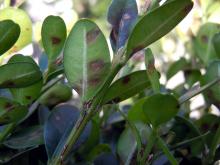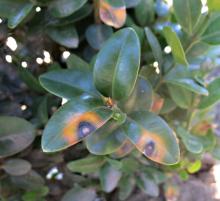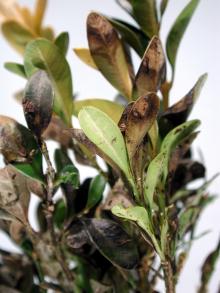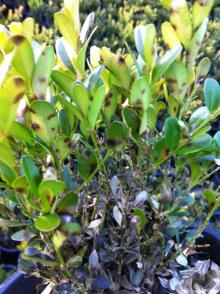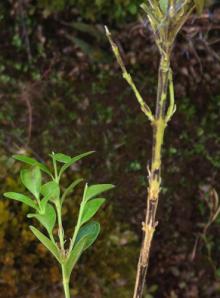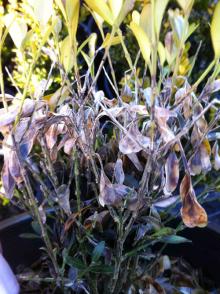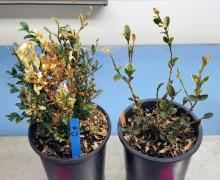Cause Boxwood blight caused by the fungus Calonectria pseudonaviculata (synonyms Cylindrocladium pseudonaviculatum or C. buxicola) was found for the first time late in 2011 in three Oregon and four British Columbia nurseries. The disease has been found in 30 states including the District of Columbia, at least 16 Oregon nurseries (in Clackamas, Linn, Marion, Multnomah, Washington, and Yamhill counties) and also in landscapes in Clackamas, Coos, Lane, Multnomah, and Yamhill counties and in Seattle, WA. The U.S. population of C. pseudonaviculata is mainly of one major DNA type and is significantly differentiated from the population found in Europe. It has been a problem for many years in Europe and New Zealand. Calonectria henricotiae also causes boxwood blight but is found only in Europe and is resistant to many fungicides.
The disease is especially severe in the landscape where plants are sheared tightly and/or planted in hedges. In nurseries, boxwood blight is severe in situations where there is high humidity or where moisture remains on leaves for long periods of time. This includes plants in propagation greenhouses, those watered too frequently without sufficient time to dry between irrigation events, or are shaded by taller plants or structures. Plants that are tightly spaced in flats, grown pot-to-pot, or other spacing where plant canopies touch each other are also at risk for more severe disease. Management of this disease has increased nursery production costs by 25%. Due to the history of this disease, its explosive life cycle, and subtle symptoms on tolerant plants, it is expected to be an ever-increasing problem throughout the PNW.
Hosts include many Buxus spp. and cultivars, Pachysandra, and Sarcococca. The three commonly grown boxwood species-Buxus sempervirens, B. microphylla (littleleaf boxwood), and B. sinica var. insularis (Korean boxwood)-are known hosts as well as B. colchica and B. microphylla var. japonica (Japanese boxwood). Tests have shown that B. microphylla 'Little Missy', B. microphylla var. japonica 'Winter Gem', B. sinica var. insularis 'Nana', and B. microphylla var. japonica 'Green Beauty' are more resistant to disease, although they still carry the fungus and severe disease can still develop if environmental conditions are conducive. For example, 'Winter Gem' is fairly resistant to boxwood blight at 77°F, but develops severe disease at cooler temperatures ranging from 59 to 68°F. Severe disease may also develop on any cultivar when canopies remain wet for extended periods of time. In Oregon nurseries, the fungus was isolated from 46 different cultivars and was frequently found on common boxwood (B. sempervirens), 'Dee Runk', 'Green Gem', 'Green Mountain', 'Green Velvet', 'Suffruticosa', and 'Winter Gem'.
The fungus can survive in fallen leaves for up to 5 years but only 3 years or less in garden soils. The fungus can produce spores in a sticky, slimy matrix when environmental conditions become suitable. Mild wet weather west of the Cascade Range is conducive for long-term survival and infection. The fungus produces long-lived survival structures called microsclerotia within infected tissue, which are released into the soil from plant debris, and can initiate new infections by producing infective spores or by being splashed onto foliage directly. The fungus penetrates the leaf through stomata and wounds. In Oregon, cool to warm (59 to 77°F) wet conditions are favorable for disease development and high humidity levels or free water is needed for infection to occur. New infections do not occur at temperatures below 43°F. Short-distance dispersal occurs through water or rain splash (especially wind-driven rain) and human activities such as pruning. Long-distance dispersal can occur through the transport of infected nursery stock or infected plant debris. Spores are unlikely to travel long distances by wind alone.
Immersion of cuttings in 117°F water for 25-30 min greatly reduced growth and sporulation of infected branches or leaves.
Volutella blight, often colonizes diseased stems associated with this disease.
Symptoms Dark or light brown spots on leaves, often in a circular or zonate pattern, black streaks or cankers on stems, straw-to bronze-colored or grayish-black blighted foliage, and defoliation. A yellow or orange halo around leaf spots may also be observed. Blighting and defoliation can occur suddenly, with complete leaf loss in severe cases. Leaf spots can grow together to cover the entire leaf surface. Downy white fungal growth may be seen on the underside of leaves. Tufts of white spores (sporodochia) may be seen along lesions. Heavily infected plants may lose leaves from the bottom of the canopy first leaving stems with a "lion tail" look. Propagation flats may have more blight toward the center than the margin of the flat.
Infected stems can have multiple diagnostic dark-brown or black lesions, either linear or diamond-shaped. The black streaks found on stems progress from the bottom of the plant up. New growth continues to develop on healthy stems, and often the root systems remain healthy and intact. Young seedlings, however, may die from this disease. Fall and winter are the best times of the year to look for the disease especially after significant rainfall. Symptoms can be very mild during hot dry summers. However, the disease can be easily found in summer in production areas that are frequently watered overhead.
Spores of the pathogen can sometimes be seen on the underside of the infected leaves. Under high humidity, white fuzzy masses comprised of large numbers of spores are sometimes visible to the naked eye or with a hand lens on infected stem and leaf tissue.
Scouting Inspect the lower and interior canopy for symptoms of the disease. It may not be found unless the canopy is parted and interior leaves and stems are examined for spots and streaks. Scout all plants on a weekly basis, especially just after warm (>55°F), wet weather. Limit activity in plantings during rainy and/or wet weather.
Cultural control To limit spread and movement of the pathogen, all confirmed infected plants should be destroyed.
- Isolate and contain new shipments of boxwood for at least a 30-day observation period. Locate the isolation area well away from existing blocks or outgoing shipments, and scout weekly.
- Break up large blocks of Buxus with non-host species to limit exposure and potential losses due to this disease.
- Do not reuse or recycle or compost infected plants, media, or containers. Professional composting is fine.
- Remove and destroy dead leaves and plant debris from within and underneath plants. Flaming was only partially successful in reducing inoculum from under contaminated plants in Virginia. In the landscape, prune off and destroy infected twigs.
- Do not grow susceptible plants in blocks or on ground that has been positive for this disease in the past.
- Prune when plants are dry and disinfest pruning equipment, especially between blocks of plants. Labeled rates of Oxidate/Zerotol have been effective as well as 40-70% ethanol or isopropanol (such as Alpet D2). Disinfestants work better on clean equipment with long contact times.
- Avoid overhead irrigation or any practice that keeps plants wet for extended periods of time or splashes water from one plant onto another.
- Space plants at least 6 inches apart and prune (thin) plants for good air circulation. Thinning is best done in the fall during dry weather using sharp bypass pruners.
- Grow tolerant and/or resistant species or cultivars but exercise caution to avoid inadvertently bringing in or shipping out infected plants.
- Grow plants in well-drained media or soil with a pH between 6.8 and 7.5. Light shade of 20% can also reduce injury from summer or winter extremes. In general, boxwood is a shade loving plant.
- Mulching with composted pine bark has helped reduce transmission to healthy plants in landscape conditions.
- Pruning plants 4 to 6 inches above the soil line has also helped reduce spread of the disease.
- Under severe landscape situations in Europe, Japanese holly (Ilex crenata) has been recommended as an alternative plant.
Chemical control Combine fungicide use with intensive scouting and cultural management. Applications to cure already-infected plants in the nursery will not be effective. Alternate or tank-mix products from different groups that have different modes of action. Use of tank-mixes or pre-packed mixes are preferred, especially using a multisite fungicide as one component of the mix. Test for phytotoxicity on a small group of plants or cultivars before widespread use, especially if surfactants are included in the mix. Good coverage is essential but difficult to achieve with dense foliage. Dilute high-volume (300 gal/A or more) applications will provide better coverage than low-volume concentrate applications.
Weather data combined with disease modeling has indicated that many infections can occur on young growth in spring during rainy weather. The potential for fall infections of older leaves is also possible when rain returns in the autumn. Focus applications in the spring beginning at bud break and continuing with wet weather. Monitor weather in the fall and apply a fungicide if warm and wet weather is forecasted.
Products that contain chlorothalonil (group M5) have excellent protective activity. FRAC group 3 materials have limited (48 hr) curative activity but can also reduce sporulation. They may also be useful to suppress sporulation prior to pruning. Use of these locally systemic materials is encouraged during periods of high susceptibility such as early spring growth or prior to moving plants. High rates of Group 3 materials may cause some marginal burning of leaves. FRAC group 11 materials have only protective activity. Reduced sensitivity to Group 11 fungicides is suspected in northeast U.S.
Immersing cuttings in a fungicide or disinfectant solution for several minutes can be an effective control tactic but is not generally recommended. A few infected cuttings can contaminate the entire batch with disastrous results. It is better to use products before cuttings are taken and/or after sticking.
Although chlorothalonil (group M5) is available in small, home packaging (from Bonide, Hi-Yield, Ferti-lome or Ortho) none are specifically labeled for this disease. It is suggested that home gardeners hire a reputable landscape company for management of high value hedges and landscapes. Both cultural and chemical tactics must be used.
- Affirm WDG at 0.25 to 0.5 lb/100 gal water. Not as effective alone. For use in greenhouse or hoop house (or similar structures), field nursery, container, and residential and commercial landscapes. Boxwood is not on the label but may legally be used. Test first on a small section before applying on the whole plant to evaluate possible phytotoxicity. Group 19 fungicide. 4-hr reentry.
- Avelyo at 3 to 5 fl oz/100 gal water. The pathogen but not the plant is on the label. Many different use sites but excludes residential sites. Group 3 fungicide. 12-hr reentry.
- Banner MAXX at 6 to 8 oz/100 gal water. Can be used in the landscape and many other sites. Boxwood is not on the label but may legally be used. Test first on a small section before applying on the whole plant to evaluate possible phytotoxicity. Some short eradicant or kick-back activity for 24 to 48 hours after infection. Group 3 fungicide. 12-hr reentry.
- BioAdvanced Disease Control at 0.75 fl oz/gal water. H
- Cleary's 3336 F at 12 to 16 fl oz/100 gal water plus another fungicide from another fungicide group. Boxwood is not specifically mentioned on the label but may legally be used. Inconsistent control. Can be used in the landscape and many other sites. Group 1 fungicide. 12-hr reentry.
- Compass 50 WDG at 1 to 4 oz/100 gal water. Do not use organosilicate additives. Boxwood is not specifically mentioned on the label but may legally be used. For use in nurseries, landscapes, greenhouses, hoop houses, or similar structures. Group 11 fungicide. 12-hr reentry.
- Concert II at 26 to 35 fl oz/100 gal water. Might leave a slight residue on leaves and/or slight plant growth regulation effect. For use in nurseries and some landscapes. Excellent control. Group 3 + M5 fungicide. 12-hr reentry.
- Daconil Weather Stik at 1.38 pints/100 gal water. Do not use with a surfactant. Excellent control. Can be used in the landscape and many other sites. Boxwood is not on the label but may legally be used. Test first on a small section before applying on the whole plant to evaluate possible phytotoxicity. Group M5 fungicide. 12-hr reentry.
- Eagle 20 EW at 6 to 12 fl oz/100 gal water. Can be used in the landscape and many other sites. Boxwood is not on the label but may legally be used. Test first on a small section before applying on the whole plant to evaluate possible phytotoxicity. Group 3 fungicide. 24-hr reentry.
- Heritage at 4 to 8 oz/100 gal water plus a non-silicone-based wetter sticker. Can be used in the landscape and many other sites. Group 11 fungicide. 4-hr reentry.
- Insignia SC at 3 to 12 fl oz/100 gal water. Do not use with organosilicate-based adjuvants. Mediocre to fair control. Can be used in the landscape and many other sites. Group 11 fungicide. 12-hr reentry.
- KleenGrow at 25 fl oz/100 gal water for greenhouse use. 48-hr reentry.
- Mancozeb-based products for nursery and greenhouse use. Group M3 fungicides. 24-hr reentry.
- Fore 80 WP at 1.5 lb/100 gal water plus a spreader-sticker. Do not use on pachysandra.
- Protect DF at 1 to 2 lb/100 gal water plus 2 to 4 oz spreader-sticker. Can be used in the landscape.
- Medallion WDG at 1 to 4 oz/100 gal water. Use with oils or adjuvants may damage plant. Can be used in the landscape and many other sites. Boxwood is not on the label but may legally be used. Test first on a small section before applying on the whole plant to evaluate possible phytotoxicity. Group 12 fungicide. 12-hr reentry.
- Mural at 4 to 7 oz/100 gal water. Do not let drift contact apple, crabapple, or privet or damage could result. Can be used in commercial landscapes and many other sites. Boxwood is not on the label but may legally be used. Test first on a small section before applying on the whole plant to evaluate possible phytotoxicity. Group 7 + 11 fungicide. 12-hr reentry.
- Orkestra at 8 fl oz/100 gal water. Can be used in the landscape and many other sites. Group 7 + 11 fungicide. 12-hr reentry.
- Pageant at 8 to 12 oz/100 gal water. Do not use with organosilicone-based adjuvants. Mediocre to good control. Can be used in the landscape and many other sites. Group 7 + 11 fungicide. 12-hr reentry.
- Palladium at 2 to 4 oz/100 gal water. Avoid excessive runoff to small plants, which may result in stunting and/or chlorosis. Can be used in commercial (not residential) landscapes and many other sites. Boxwood is not on the label but may legally be used. Test first on a small section before applying on the whole plant to evaluate possible phytotoxicity. Group 9 + 12 fungicide. 12-hr reentry.
- Postiva at 10 to 28 fl oz/100 gal water. Can be used in the landscape and many other sites. Group 3 + 7 fungicide. 12-hr reentry.
- ProCon-Z at 5 to 8 oz/100 gal water. Can be used in the landscape and many other sites. Boxwood is not on the label but may legally be used. Test first on a small section before applying on the whole plant to evaluate possible phytotoxicity. Group 3 fungicide. 24-hr reentry.
- Spectro 90 WDG at 1 to 2 lb/100 gal water. Many turf sites need to be avoided. Boxwood is not on the label but may legally be used. Test first on a small section before applying on the whole plant to evaluate possible phytotoxicity. Group 1 + M5 fungicide. Excellent control. 12-hr reentry.
- Spirato GHN at 2 to 4 fl oz/100 gal water. Use with oils or adjuvants may cause plant damage. Can be used in the landscape and many other sites. Group 12 fungicide. 12-hr reentry.
- Terraguard SC at 4 to 8 fl oz/100 gal water. For use in nurseries and greenhouses. Boxwood is not on the label but may legally be used. Test first on a small section before applying on the whole plant to evaluate possible phytotoxicity. Group 3 fungicide. 12-hr reentry.
- Torque at 8 to 10 fl oz/100 gal water. For use in landscapes and container grown ornamentals. Applications may result in plant growth regulation effects with smaller, thicker, greener leaves and shortened internodes that may be unacceptable to customers. Group 3 fungicide. 12-hr reentry.
- Tourney EZ at 4 oz/100 gal water. Can be used in the landscape and many other sites. Group 3 fungicide. 12-hr reentry.
Forecasting: The boxwood blight infection risk model estimates first infections and degree of infection risk. The model, as delivered through the USPest website, uses hourly weather data and works well for the two susceptible cultivars it was based upon. The model assumes that infectious inoculum is present and that infection occurs during periods of leaf wetness caused by dew or rain. In some regions, such as the southeastern U.S., high humidity may contribute to leaf wetness not currently accounted for in this model. The model may therefore sometimes under-predict disease under high relative humidity conditions.
References Castroagudín, V. L., Yang, X., Daughtrey, M. L., Luster, D. G., Pscheidt, J. W., Weiland, J. E., and Crouch, J. A. 2020. Boxwood blight disease: A diagnostic guide. Plant Health Progress, 21:291-300.
LaMondia, J. A. 2020.Curative fungicide activity against Calonectria pseudonaviculata, the boxwood blight pathogen. Journal of Environmental Horticulture 38(2):44-49
Omolehin, O., Keller, J., Gouker, F., Daughtrey, M., Luster, D., Pscheidt, J. and Hong, C., 2023. Combating an Invasive Boxwood Pathogen-Calonectria pseudonaviculata-in the United States by Shifting Production to Less-Susceptible Cultivars. Plant Disease, 107:2185-2196.
Weiland, J. E., Ohkura, M., Scagel, C. F., Davis, A. E., and Beck, B. R. 2022. Cool temperatures favor growth of Oregon isolates of Calonectria pseudonaviculata and increase severity of boxwood blight on two Buxus cultivars. Plant Disease. 106:3100-3108. https://doi.org/10.1094/PDIS-04-22-0769-RE.

